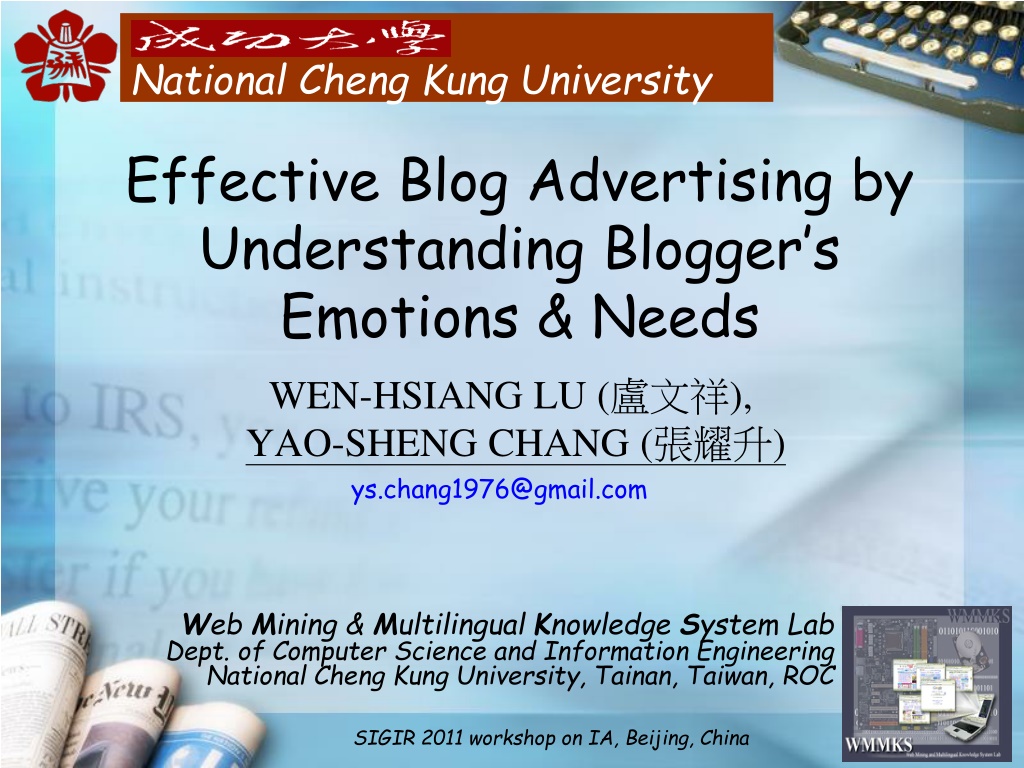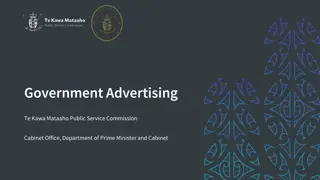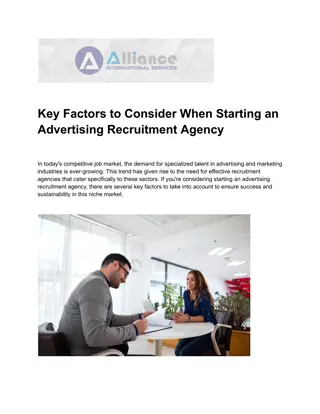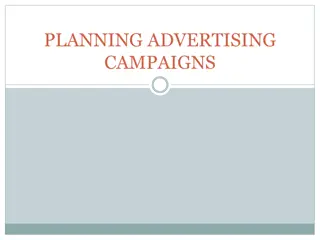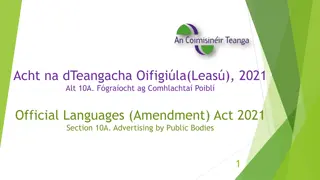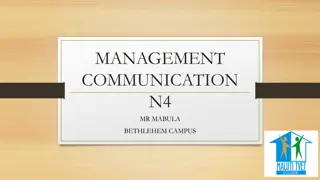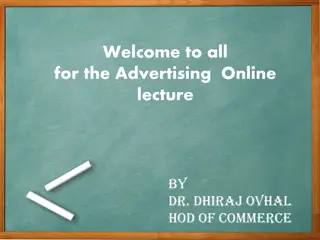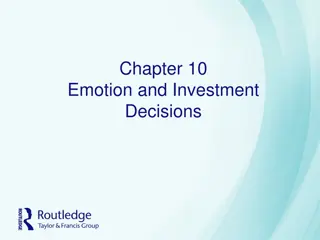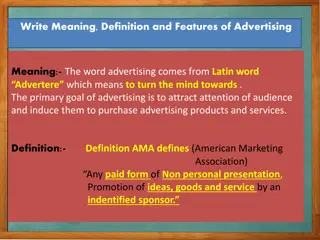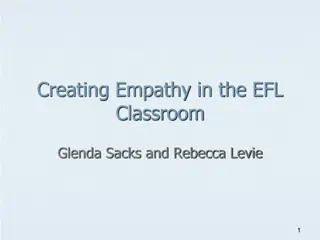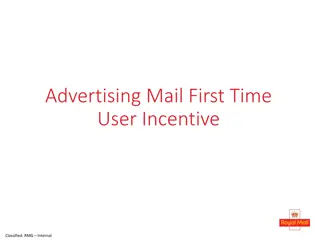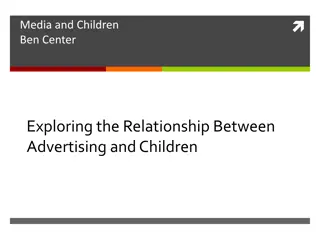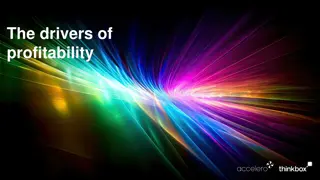Understanding Blogger Emotions and Needs for Effective Blog Advertising
National Cheng Kung University researchers present an Event-driven Emotion-Need-based Advertising model (EENA model) to improve ad recommendations by understanding bloggers' emotions and needs. The study analyzes emotions and needs in blog articles related to life events, aiming to provide more relevant and contextual advertisements. By uncovering hidden emotions and needs, the model can offer personalized ad suggestions for bloggers, enhancing user engagement and advertising effectiveness.
Uploaded on Sep 27, 2024 | 0 Views
Download Presentation

Please find below an Image/Link to download the presentation.
The content on the website is provided AS IS for your information and personal use only. It may not be sold, licensed, or shared on other websites without obtaining consent from the author. Download presentation by click this link. If you encounter any issues during the download, it is possible that the publisher has removed the file from their server.
E N D
Presentation Transcript
National Cheng Kung University National Cheng Kung University National Cheng Kung University National Cheng Kung University Effective Blog Advertising by Understanding Blogger s Emotions & Needs WEN-HSIANG LU ( ), YAO-SHENG CHANG ( ) ys.chang1976@gmail.com Web Mining & Multilingual Knowledge System Lab Dept. of Computer Science and Information Engineering National Cheng Kung University, Tainan, Taiwan, ROC WMMKS-loggo SIGIR 2011 workshop on IA, Beijing, China
Outlines Introduction Proposed approach Event-driven Emotion-Need-based Advertising model (EENA model) Experiments Conclusions and future works WMMKS-loggo 2
Introduction More and more advertising systems have been developed by Web service providers to display contextual ads Generally, most existing advertising systems adopt the following methods topic-relevant advertising methods keyword-matching-based advertising methods advertiser-bidded topic keywords matching methods WMMKS-loggo 3
An unsuitable example of Ad recommendation Google Ads Emotion Life Event No correspondence to bloggers needs Need WMMKS-loggo 4
Observation The analysis of emotions and needs on the randomly selected 30 blog articles for five frequent life events. Frequent Emotions Terms Positive (joyful) (enjoy) (cute) Frequent Life Events Frequent Needs Negative (afraid) (careful) (embarrassing) (affection) (mahjong) (return to Taiwan) (public security) (restaurant) (around the Island) (travel) (credit points) (homework) (travel) (book) (change job) (travel) (concert) (restaurant) (go home) (enjoy) (cute) (joyful) (afraid) (regretted) (doubt) (leave home) (joyful) (enjoy) (cute) (enjoy) (hope) (funny) (enjoy) (not bad) (joyful) (fearful) (bored) (terror) (worry) (dislike) (bored) (nervous) (worry) (regretted) (attend class) (go to work) (take a break) WMMKS-loggo 5
Observations & Goals Observations Blog Event Bloggers write articles to describe something happened about life. Blog Emotion Life events cause various feelings. Blog Need Life events and emotion cause various needs (e.g., cake, ring and gift, etc.) Goals To understand bloggers (writers) hidden emotion & needs in the blog posts. Then to recommend ads corresponding to bloggers (writers) hidden emotion & needs. WMMKS-loggo 6
Challenge However, a number of challenges in implementing this framework will be described below. 1. How to detect affective blog articles from any given blog article. 2. How to detect the terms of bloggers life event, emotions and needs from the unstructured text data in a given affective blog article. 3. How to deliver appropriate ads to an affective blog article. WMMKS-loggo 7
Idea Utilize bloggers (writers) hidden emotion & needs to recommend suitable ads WMMKS-loggo 8
Proposed Method (1) Event-DrivenEmotion-Need-Based Advertising Model EENA Model Ads Affective Blog Article Recommended Ads Matching Event Extraction Emotion Extraction Need Extraction A blog article b can be represented as a triple b = (e, mi, nj), a life event e (assuming that a blog article has only one event) some implicit emotion terms mi M, and needs nj N, Given an affective blog article b and an advertising set A to recommend some appropriate ads a A ? ? ? ? ? ? = ? ?? ?? ?,??? = ?? ?? ??? ? ? ?,??(1) ? ? ? WMMKS-loggo 9
Proposed Method (2) Event-drivenEmotion-Need-Based Advertising Model ? ? ? ? ? ? = ? ?,??? = ? ??? ? ? ?,?? (1) ?? ? ?? ? ? ? ?,?? = ? ?? ?? ?,?? ? ? ?,??,??(2) ? ? ? = ?? ?? ??? ?? ?? ???,??? ? ?,??,??.(3) Emotion model Advertising model Need model WMMKS-loggo 10
Experiments TrainingData Set Blog articles (Pixnet): 115,551 articles Advertisings (Kijiji): 61,424 ads. Emotional terms 458 Chinese emotion words are collected from a Chinese website and then are extended with an additional 2,248 emotion words using a Chinese Synonym Thesaurus. After manually filtering, 1,216 emotion words are divided into two categories, including positive and negative . WMMKS-loggo 11
Experiments Baseline Need Inference: Take blogger s need inference as classification problem, thus each need is considered as a class. SVM classifier as the baseline, with bag of words as features. Ads Matching: keyword-matching-based advertising method as the baseline. the event terms as keywords to match suitable ads from the collected ad corpus. WMMKS-loggo 12
Experiments Need Inference Event (birthday), (break up), (get marry). Randomly selected 100 articles respectively as testing data. Life Event Need Model SVM (baseline) 0.3191 0.229 (birthday) 0.2745 0.278 (break up) (get marry) 0.4050 0.323 WMMKS-loggo 13
Experiments Ads Matching The event get marry , the top-1 inclusion rate of our EENA model outperforms the baseline by 14.96% (0.2095 vs. 0.06). However, the precision of the first event birthday is lower than that of baseline. After our analysis, need for birthday is too diverse to lead to good results. the number of training data is not enough and thus make the recall rate is lower than baseline. Metrics Events TOP 1 0.0590 TOP 5 0.1196 TOP 20 0.3259 TOP 1 0.3429 TOP 5 0.3429 TOP 10 0.8143 TOP 1 0.2095 TOP 5 0.3552 TOP 20 0.6702 14 Inclusion Rate F-measure EENA Baseline EENA Baseline 0.0654 0.1969 0.4893 0.1385 0.2483 0.5269 0.0600 0.2406 0.4839 0.0037 0.0143 0.0518 0.0667 0.0512 0.1708 0.0196 0.0488 0.0930 0.0089 0.0309 0.0940 0.0456 0.0667 0.1136 0.0236 0.0549 0.0776 (birthday) (break up) WMMKS-loggo (get marry)
Correct Example WMMKS-loggo 15
Conclusion & Future work We carefully proposed an event-driven emotion-need-based advertising model and developed a feasible framework to solve problems of conventional keyword- matching-based advertising approach which often recommends unsuitable ads. In the future, we will develop an automatic mechanism to extract life events, emotions and needs for large-scale ad matching. WMMKS-loggo 16
Thanks for your listening. Q & A WMMKS-loggo 17
WMMKS-loggo 18
